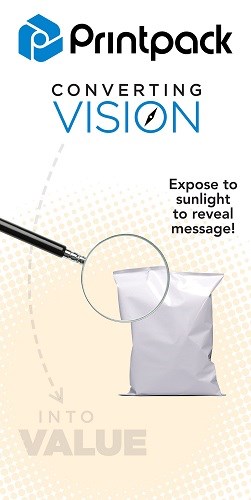Photochromic Ink for Flex Packaging Helps Brand
Printpack's process allows for photochromic ink to be hidden and remain invisible until exposed to sunlight.


At last week’s Pack Expo in Las Vegas, a new way for brands to interact and engage with consumers was launched by Atlanta, Ga. The company has developed a proprietary process that allows for photochromic ink to be hidden within standard graphics and remain invisible until exposed to sunlight.
Printpack showed a sample application of its technology at the show, whereby attendees could see the package transform firsthand. According to the company, this process represent the first time photochromic ink has been applied to a flexible film, giving brand owners in any market that utilizes flexible packaging new options for interacting with their customer base.
The application of photochromic ink for the flexible packaging industry for years had been a challenge, particularly in high-speed production environments—in turn limiting options for brand owners looking to differentiate their product. Printpack’s R&D team designed the innovative process to apply the ink while still upholding the integrity of the packaging design and graphics to the highest standards, according to the company.
Printpack says interactive packaging is proven to capture consumer attention and encourages engagement with the brand in a meaningful way. Notes director of technology Mark Brogan, “This type of packaging application can truly set a brand apart by adding depth to the consumer experience. It can make all the difference when it comes to purchasing decisions.”
Related Content
-
Low-Smoke, Non-Halogen Polyolefinic Compound for Armored Cables
Avient’s latest addition to its ECCOH portfolio is designed to prevent environmental stress cracking in low- and medium-voltage cable sheathing.
-
Inline Measurement Adds Module for Inspection of High-Gloss Vehicle Trims
Pixargus’ Shiny Detection module casts a pattern of structured light onto the high-gloss surfaces of the profiles to be inspected.
-
Next-Generation Fully Electric Ultrasonic Welding System
NPE 2024: Rinco new eMotion servo-driven machine is available in 20 kHZ and 35 kHz frequencies.







